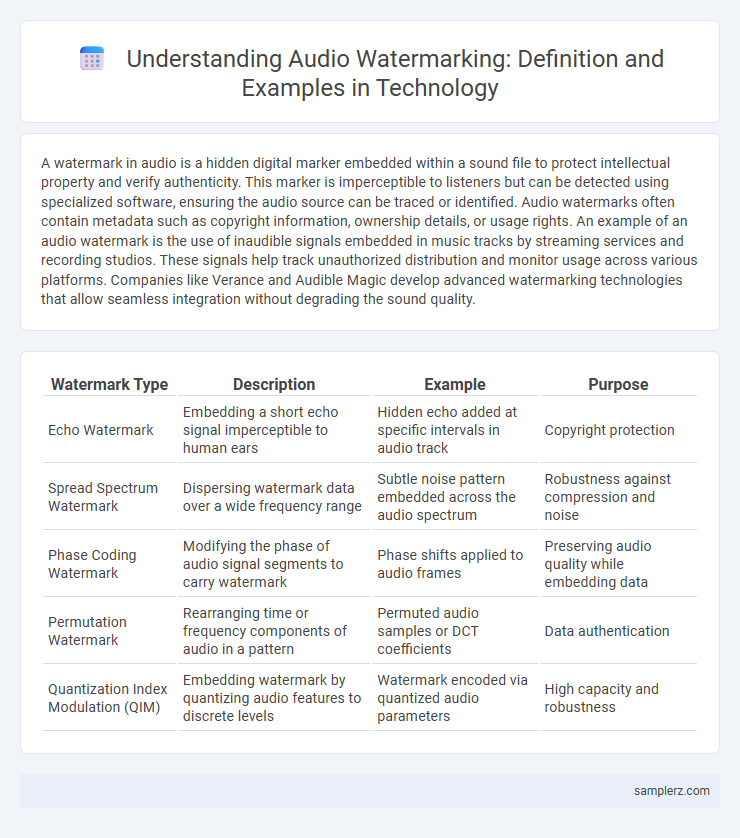A watermark in audio is a hidden digital marker embedded within a sound file to protect intellectual property and verify authenticity. This marker is imperceptible to listeners but can be detected using specialized software, ensuring the audio source can be traced or identified. Audio watermarks often contain metadata such as copyright information, ownership details, or usage rights. An example of an audio watermark is the use of inaudible signals embedded in music tracks by streaming services and recording studios. These signals help track unauthorized distribution and monitor usage across various platforms. Companies like Verance and Audible Magic develop advanced watermarking technologies that allow seamless integration without degrading the sound quality.
Table of Comparison
| Watermark Type | Description | Example | Purpose |
|---|---|---|---|
| Echo Watermark | Embedding a short echo signal imperceptible to human ears | Hidden echo added at specific intervals in audio track | Copyright protection |
| Spread Spectrum Watermark | Dispersing watermark data over a wide frequency range | Subtle noise pattern embedded across the audio spectrum | Robustness against compression and noise |
| Phase Coding Watermark | Modifying the phase of audio signal segments to carry watermark | Phase shifts applied to audio frames | Preserving audio quality while embedding data |
| Permutation Watermark | Rearranging time or frequency components of audio in a pattern | Permuted audio samples or DCT coefficients | Data authentication |
| Quantization Index Modulation (QIM) | Embedding watermark by quantizing audio features to discrete levels | Watermark encoded via quantized audio parameters | High capacity and robustness |
Understanding Audio Watermarks: Definition and Importance
Audio watermarks embed imperceptible digital codes within sound files, enabling content owners to track and protect intellectual property against unauthorized use. These watermarks maintain audio quality while facilitating real-time monitoring and verification in streaming platforms and broadcast media. Understanding audio watermarking technology is crucial for securing digital rights management and enhancing anti-piracy measures in the rapidly evolving audio industry.
Types of Audio Watermarks Used in Digital Media
Audio watermarks in digital media primarily include perceptible and imperceptible types, each serving distinct purposes like copyright protection and content authentication. Perceptible watermarks alter the audio track at a noticeable level, often embedding sounds such as logos or beeps, while imperceptible watermarks use subtle frequency modifications or phase shifts that remain undetectable to listeners. Techniques like spread spectrum, echo hiding, and patchwork watermarking enhance robustness against compression and signal processing in streaming platforms and digital broadcasting.
How Audio Watermarks Enhance Content Security
Audio watermarks embed inaudible signals within sound files to protect intellectual property and verify content authenticity. These digital signatures enable tracking of unauthorized distribution by monitoring watermarked audio across platforms. Enhanced content security is achieved as watermarks resist tampering while preserving audio quality, ensuring reliable identification of original sources.
Real-world Examples of Audio Watermarking in Streaming Platforms
Audio watermarking in streaming platforms is exemplified by Spotify's use of inaudible digital markers to track song playback and prevent piracy. Apple Music integrates audio watermarking to identify unauthorized distribution by embedding unique codes in tracks during streaming. These watermarks enable content owners to monitor usage and enforce copyright protection without disrupting the listener experience.
Audio Watermark Applications in Copyright Protection
Audio watermarking embeds imperceptible signals into sound recordings to safeguard intellectual property rights by enabling content traceability and ownership verification. This technology is widely applied in copyright protection across music streaming platforms, digital downloads, and broadcasting, effectively deterring unauthorized distribution and piracy. Enhanced robustness and imperceptibility of audio watermarks ensure minimal impact on sound quality while maintaining secure authentication and licensing enforcement.
Audio Watermark Detection Techniques and Tools
Audio watermark detection techniques leverage signal processing algorithms such as spread spectrum, echo hiding, and patchwork methods to identify embedded imperceptible markers within audio signals. Tools like Sonic Visualiser, MATLAB Signal Processing Toolbox, and proprietary software utilize correlation analysis and machine learning models to extract and verify watermarks efficiently under various distortions. Effective detection ensures copyright protection and content authentication by maintaining robustness against noise, compression, and audio transformations.
Case Study: Audio Watermark Use in Broadcasting
The case study of audio watermark use in broadcasting highlights how major networks embed imperceptible digital watermarks within their audio streams to verify content authenticity and prevent unauthorized redistribution. Techniques such as spread-spectrum watermarking enable broadcasters to maintain broadcast integrity without affecting listener experience. This method enhances copyright enforcement and facilitates efficient content tracking across multiple platforms.
Challenges and Limitations in Audio Watermark Implementation
Audio watermark implementation faces challenges such as maintaining imperceptibility while ensuring robustness against signal processing attacks like compression and filtering. Limitations include vulnerability to synchronization errors and the trade-off between watermark strength and audio quality degradation. Effective watermarking must balance computational complexity with real-time processing demands in various digital audio environments.
Future Innovations in Audio Watermark Technology
Future innovations in audio watermark technology leverage artificial intelligence and machine learning to enhance robustness and imperceptibility in digital audio fingerprints. Advanced codecs and neural networks enable real-time embedding and extraction of watermarks, ensuring secure content authentication across streaming platforms. Quantum-resistant encryption techniques are being developed to protect audio watermarks against emerging cybersecurity threats and unauthorized distribution.
Best Practices for Embedding Watermarks in Audio Files
Embedding watermarks in audio files requires using imperceptible frequencies or phase shifts to maintain audio quality and prevent detection. Best practices include choosing robust watermarking algorithms that resist common audio processing such as compression and filtering, ensuring the watermark remains intact throughout distribution. Regularly testing embedded watermarks against various playback environments ensures durability and effectiveness in protecting intellectual property.

example of watermark in audio Infographic
 samplerz.com
samplerz.com